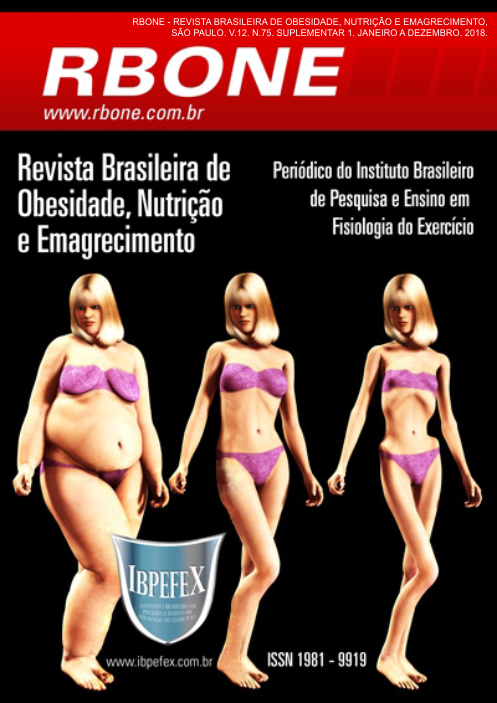Association of perception of body image with the resistance and cardiac index of adiposity in practitioners of physical exercises
Abstract
The performance of physical activities promotes several benefits to the body. However, with the social pressure to reach a pattern of ideal beauty, it is observed, in the present days, a high dissatisfaction with the own image. To assess the degree of satisfaction with own body, the present study aimed to associate body image perception, body adiposity index (BAI) and cardiac resistance. These variables were evaluated through the Ruffier-Dickson test, the BAI calculation and the Kakeshita's silhouettes scale (2009), making a comparative analysis among the individuals. The sample consisted of 30 physical exercise practitioners in a Joinville gym, of which 20 were women between the ages of 21 and 45 years, and the mean age was 28.6 (± 6.0) and 10 males aged 18 and 45 years, and mean age of 30.1 (± 8.1). After analysis, it was observed that 60% of the evaluated individuals have weak or very weak cardiac resistance, even if they're active in the gym. Regarding body image perception, the results suggested a dissatisfaction with the body itself, in which 51% of females and 27% of males overestimated their body size. It can be seen, therefore, that the evaluated sample, besides not having a good physical conditioning, is not satisfied with its own body, seeing themselves in a negative way.
References
-Amoretti, R.; Brion, R. Cardiologia do esporte. São Paulo. Manole. 2001. p. 82.
-Andrade, A.; Bosi, M.L.M. Mídia e subjetividade: impacto no comportamento alimentar feminino. Revista de nutrição. Campinas. Vol. 16. Num. 1. 2003. p. 117-125.
-Araújo, C.G.S.; Pinto, V.L.M. Frequência cardíaca máxima em testes de exercício em esteira rolante e em cicloergômetro de membros inferiores. Arquivos brasileiros de cardiologia. Vol. 85. Num. 1. 2005. p. 45-50.
-Assunção, S.S.M. Dismorfia muscular. Revista brasileira de psiquiatria. São Paulo. Vol. 24. Num. 3. 2002. p. 80-84.
-Bergman, R.N.; Stefanovski, D.; Buchanan, T.A.; Summer, A.E.; Reynolds, J.C.; Sebring, N.G.; Xiang, A.H.; Watanabe, R.M. Um índice melhor de adiposidade corporal. Revista Obesity. Vol. 19. Num. 5. 2011. p.1083-1089.
-Borfe, L.; e colaboradores. Associação entre a obesidade infantil e a capacidade cardiorrespiratória: revisão sistemática. Revista brasileira promoção da saúde. Fortaleza. Vol. 30. Num. 1. 2017. p. 118-124.
-Caspersen, C.J.; Powell, K.E.; Christenson, G.M. Physical activity, exercise, and physical fitness: definitions and distinctions for health-related research. Public health reports. Vol. 100. Num. 2. 1985. p. 126.
-Ghorayeb, N.; Costa, R.V.C.; Castro, I.; Daher, D.J.; Oliveira Filho, J.A.; Oliveira; M.A.B.; e colaboradores. Diretriz em Cardiologia do Esporte e do Exercício da Sociedade Brasileira de Cardiologia e da Sociedade Brasileira de Medicina do Esporte. Arq Bras Cardiol. Vol. 100. Num. 1.Supl. 2. 2013. p. 1-41.
-Granell. J.C.; Cervera. V.R. Teoria e planejamento do treinamento desportivo. Porto Alegre-RS. ArtMed. 2003. p. 84.
-Jucá, E.O. Análise de Correlação dos Índices de Adiposidade Corporal, Massa Corporal e do Percentual de Gordura Corporal em Escolares do Município de Porto Velho. 2013. Disponível em: <http://www.def.inir.br/downloads/1921monografiaedicleidproducaofinal.pdf>. Acesso em: 18/06/2017.
-Kakeshita, I.S.; Silva, A.I.P.; Zanatta, D.P.; Almeida, S.S. Construção e fidedignidade teste-reteste de escalas de silhuetas brasileiras para adultos e crianças. Psicologia: teoria e pesquisa. Vol. 25. Num. 2. 2009. p. 263-270.
-Marins, J.C.B.; Luiz, A.; Monteiro, A.; Jesus, G. de. Validação do tempo de mensuração da frequência cardíaca após esforço submáximo a 50 e 80%. Rev. Bras. Med. Esporte. Vol. 4. Num. 4. 1998. p. 114-119.
-Martins, C.R.; Pelegrini, A.; Matheus, S.C.; Petroski, E.L. Insatisfação com a imagem corporal e relação com estado nutricional, adiposidade corporal e sintomas de anorexia e bulimia em adolescentes. Revista Psiquiatria. Vol. 32. Num. 1. 2010. p. 19-23.
-Pereira Junior, A.A., Rohlfs, I.C.P.M.; Lima, W.C.; Dependência ao exercício físico e a síndrome do excesso de treinamento: consequências do excesso de exercício. Revista da Unifebe. Num. 7. 2009.
-Petroski, E.L.; Pires-Neto, C.S.; Glaner, M.F (organizadores). Biométrica. 1ª edição. Jundiaí. Fontoura. 2010. p. 169.
-Silva, A.B.; Dalvi, L.T.; Amorim, M.F.; Raso, W.; Avaliação do perfil dos frequentadores de academia do plano piloto. Revista Brasileira de Obesidade, Nutrição e Emagrecimento. Vol. 1. Num. 2. 2007. p. 47-54. Disponível em: <http://www.rbone.com.br/index.php/rbone/article/view/17>
-Silverthorn, D.U. Fisiologia Humana: uma abordagem integrada. 5ª edição. Porto Alegre. Artmed. 2010. p. 259.
-Tavares, M.C.G.C.F. Imagem corporal: conceito e desenvolvimento. 1ª edição brasileira. Barueri-SP. Editora. Manole. 2003. p. 145.
-Teixeira, P.C.; e colaboradores. A prática de exercícios físicos em pacientes com transtornos alimentares. Revista de Psiquiatria Clínica. Vol. 36. Num. 4. 2009. p. 145-152.
-Vigitel (Vigilância de Fatores de Risco e Proteção para Doenças Crônicas por Inquérito Telefônico), 2016. Disponível em: <http://portalarquivos.saude.gov.br/images/pdf/2017/abril/17/Vigitel_17-4-17-final.pdf>. Acesso em 05/11/2017.
Authors who publish in this journal agree to the following terms:
- Authors retain the copyright and grant the journal the right of first publication, with work simultaneously licensed under the Creative Commons Attribution License BY-NC which allows the sharing of the work with acknowledgment of the authorship of the work and initial publication in this journal.
- Authors are authorized to enter into additional contracts separately for non-exclusive distribution of the version of the work published in this journal (eg, publishing in institutional repository or book chapter), with acknowledgment of authorship and initial publication in this journal.
- Authors are allowed and encouraged to post and distribute their work online (eg, in institutional repositories or on their personal page) at any point before or during the editorial process, as this can bring about productive change as well as increase impact and impact. citation of published work (See The Effect of Free Access).






